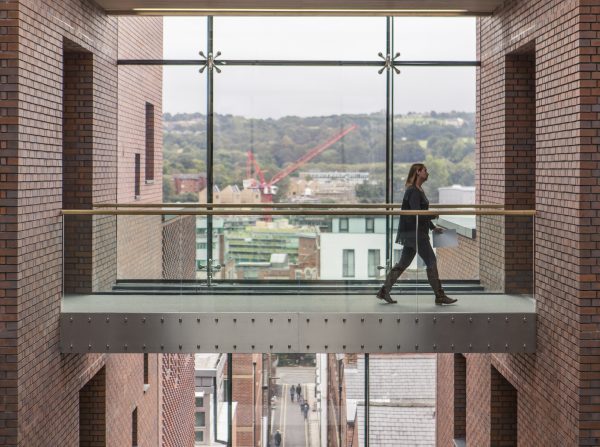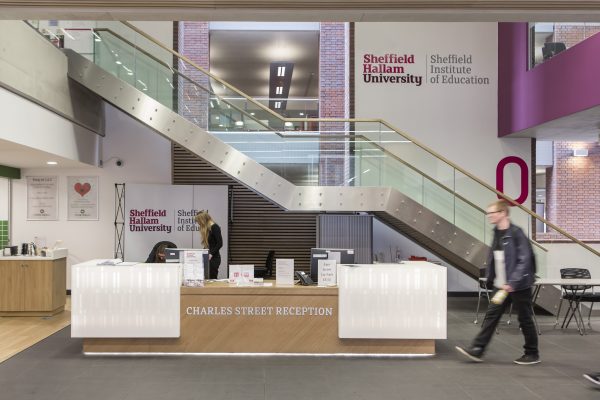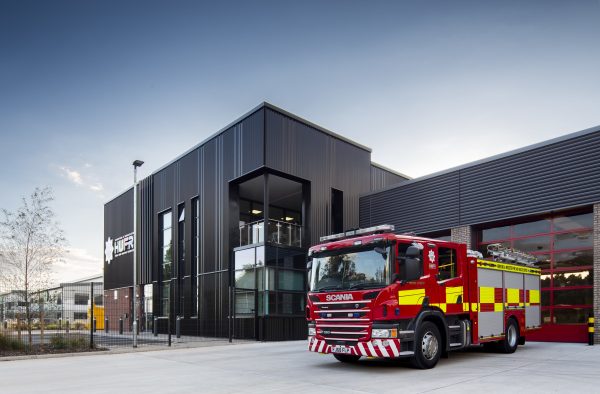
Charles Street at Sheffield Hallam University
The Charles Street building forms a cornerstone of Sheffield Hallam University’s estate masterplan, consolidating several facilities into one high-quality, space efficient campus.
This 9,500m² landmark development houses the Faculty of Development and Society alongside versatile social, teaching, and learning spaces.
Located within a conservation area, the design successfully integrates historical context with contemporary educational needs, creating a dynamic space for students and the local community.




Value
This building delivers a flexible, future-proof space that encourages innovative teaching and learning, supporting the university’s vision for modern education. The integration of the building with the city ensures enhanced campus connectivity, attracting more students and allowing for cross-sector collaboration.
The use of 3D BIM modelling further streamlined the design process, ensuring cost efficiency and reducing onsite disruptions. The project also reinforced Sheffield Hallam’s status as a key player in the city’s academic and architectural landscape.
“Designed as the iconic new home for the Sheffield Institute of Education the Charles Street building brings together teacher education provision and research in a state-of-the-art teaching, learning and social space. Exceptional thought has been given to the design in the ways in which formal and informal learning happens, to opportunities for students and academics to work together, and to integrating technology into learning. The result is a modern, flexible and vibrant space and environmentally sustainable building that will that benefit all those studying at, working at or visiting Sheffield Hallam. It’s fantastic that the University can now add this impressive new space to our estate portfolio and provide another high-quality building to further enhance the cityscape of Sheffield”



Impact
The Charles Street building revitalises the area by transforming a historic lane into an active, engaging public space. By encouraging movement through the building, it connects the campus to the surrounding city, providing a welcoming environment for students, residents, and visitors.
The integration of public art and local collaborations creates a lasting link between the university and the community, while seminar and conference facilities bridge the gap between academia and local businesses.

Sustainability
The building’s design promotes long-term sustainability by prioritising flexible and efficient use of space. The use of BIM technology helped optimise environmental performance, including natural daylighting and energy efficiency, reducing the building’s carbon footprint. The design also incorporated sustainability into its operational aspects with efficient heating, ventilation, and air conditioning systems, minimising energy consumption.





Details
Information
Scope Architectural Design Status Completed Completion Date 2016 Location Sheffield Value £19mCollaborators & Partners
Landscape Architect BondBryan Interior Designer BondBryan Principal Contractor Balfour Beatty Structural Engineer SKM MEP Engineer CPW Planning Consultant BondBryan Fire Engineer Hoare Lea Environmental Consultant CPW Acoustic Consultant Hoare Lea Mechanical Engineer Forward Mech Electrical Engineer Recon Electric Plumbing Engineer MarineAwards
Education Project Of The Year - Brick Development Awards 2017 Innovation In Teaching And Learning - Education Estates Awards 2017 Shortlisted Best Building RIBA - Civic Trust Sheffield Design Awards 2016 Shortlisted Project Of The Year - Celebrating Construction In South Yorkshire Awards 2016 Shortlisted Regeneration Award - RICS Awards 2017 Shortlisted – Education Project Of The Year - Schuco Excellence Awards 2017 – 2017 Shortlisted - RIBA Regional Award 2018Appendix
1
Get in touch:
Matt, CEO
